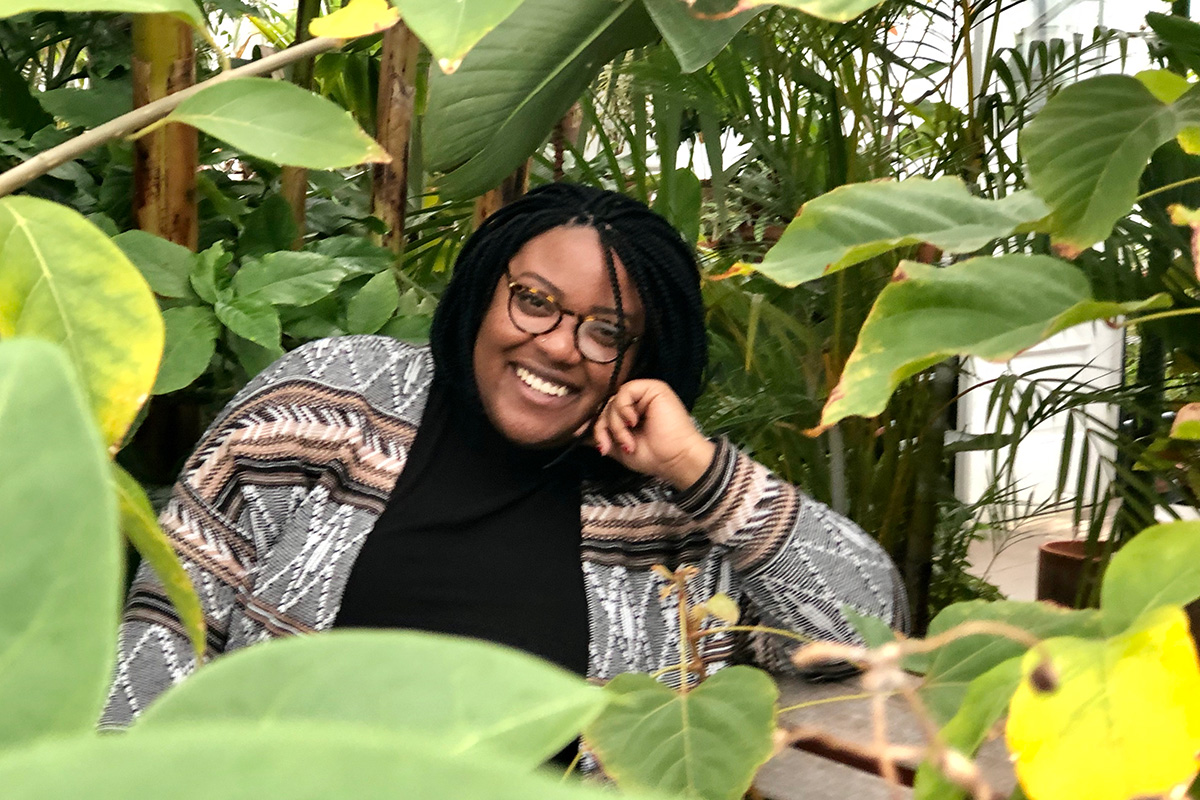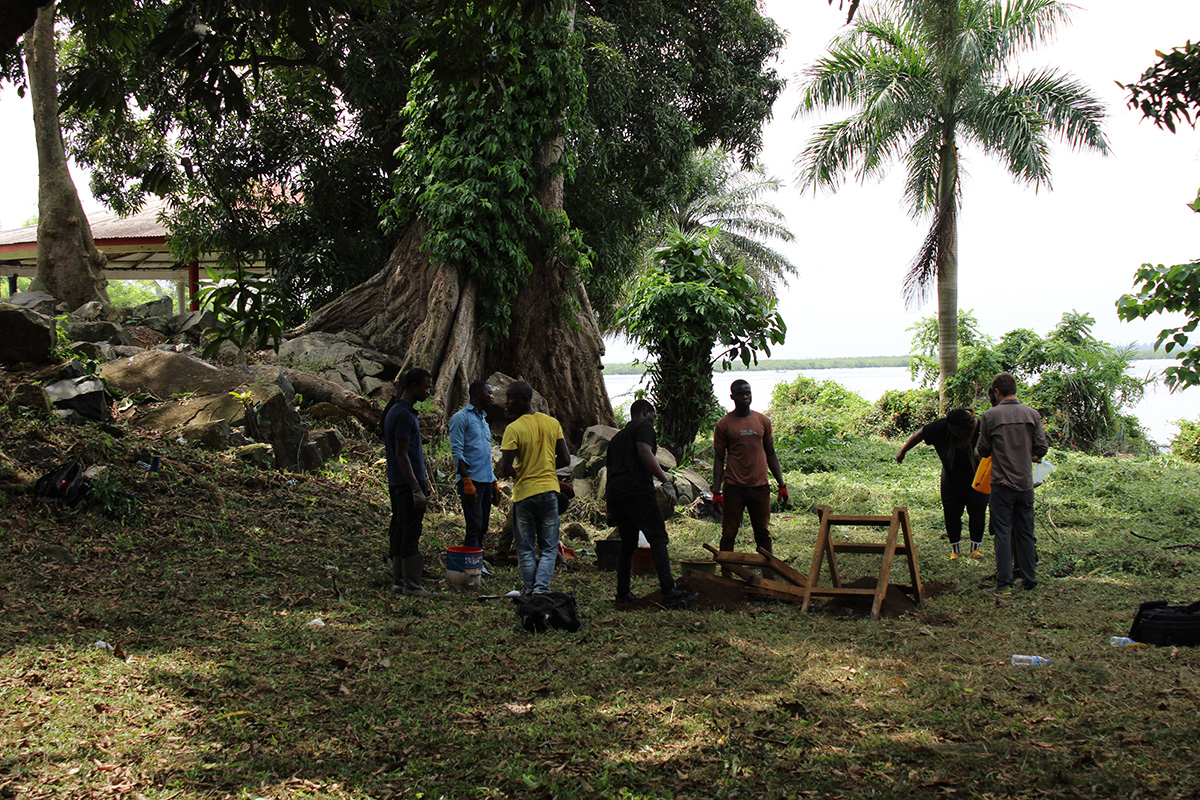Perspectives on Heritage
Chrislyn Laurie Laurore, a doctoral candidate in the Department of Anthropology, is studying the public memory and history of slavery, particularly its curation in museums, monuments, memorials, and archaeological sites.
When Anthropology PhD candidate Chrislyn Laurie Laurore began her undergraduate studies, she entertained the idea of med school, but it was her anthropology classes that led to an infectious yearning to understand the idea of heritage, how its significance aligned and contrasted depending on points of view and geography.
This quest was solidified when Laurore studied abroad. She became fascinated with what she refers to as “diaspora heritage tourism,” and this became the focus of her graduate research at Penn. Laurore, a William Fontaine Fellow now working on her dissertation, talked with Omnia about what her travels have taught her about contemporary Black identity.
What led you to your eventual scholarly interests?
I grew up in an immigrant Caribbean family in South Florida, and being a third-culture kid really led me toward pursuing anthropology. Science wasn’t my strong suit, but I loved history and culture and languages and just found myself coming back to anthropology classes time and time again; it allowed me to better understand myself, my family, my upbringing, and the world around me.
I had the opportunity to study abroad in South Africa while I was an undergrad and that was a pretty transformative experience. While there, I learned so much about the history of apartheid and about heritage as a concept because that was very much front and center in all of the classes that I took. I had taken Black studies classes before, but after that semester, I decided I wanted to double major in it.

Chrislyn Laurie Laurore, a doctoral candidate in the Department of Anthropology. (Image: Courtesy Chrislyn Laurore)
How does the idea of heritage look in the States compared to abroad?
In South Africa, categories around race are a bit different. I specifically remember people knowing that I was American and whenever the term “colored” would be used, they’d say, “Oh, no, no, no, it’s not an offensive thing—it’s not a slur. This is its own racial category.” And the idea of the “one-drop rule” also doesn’t apply as much in other contexts in other parts of the world.
But then, also, African-American culture is also such a big export, and you definitely witness how much that has shaped Blackness in other parts of the world. When you go out on Long Street in Cape Town, for example, you’ll hear Stevie Wonder records in certain lounges all night, and everyone’s up and dancing. If you go to a club, they’ll be playing hip hop.
Much of your research about heritage and cultural memory focuses on Liberia. Why?
In a first-year Africana studies pro seminar that all graduate students in the concentration have to do, we read this book-length letter by the Reverend Alexander Crummell, published in 1861, called The Relations and Duties of Free Colored Men in America to Africa. He was a free person of color from the U.S. who was educated at Cambridge and was one of the early settlers in Liberia. This treatise was him urging other free people of color in the Americas to emigrate to Liberia and help develop the country.
I had heard about Liberia but did not really know too much about the history, and much of the language sounded reminiscent of the ways that Europeans would talk about different parts of the continent and basically every place outside of Europe. I was kind of shocked by this and thought to myself, “Okay, there’s a lot more digging for me to do.”
Then I heard Matthew Riley, a professor of archaeology from the City College of New York, give a talk. He had spent his career doing plantation archaeology in Barbados and stumbled across More Auspicious Shores, Caree Banton’s book on the history of Barbadian migration to Liberia in 1865. Riley went to Liberia on a whim to learn more about the descendants of the community of settlers from Barbados. I spoke to him after his talk, and from there, we stayed in contact. He told me they were planning an archaeology field season in Liberia, and I asked to join. That’s how that trajectory started.
Can you describe your work in Liberia?
Most of my work as a Research Assistant has been with the Back-to-Africa Heritage & Archaeology project and the National Museum of Liberia. An institution like a national museum has a particular mission, trying to tell a broad, national story, and I think that definitely shaped the kinds of narratives being told. So did its audience: a large expat community of NGO workers, embassy workers, school groups, and special delegations from other countries. There’s also a history of conflict, where the museum was looted and lost a lot of its collections and records and documentation. So they’re contending with multiple complexities, as well as a chronic lack of resources.

The Back-to-Africa Heritage & Archaeology team on Providence Island in Monrovia, Liberia, during the Summer 2023 field season. (Image: Courtesy Chrislyn Laurore)
The museum as a whole promotes this very linear story of progress from pre-history, or what folks would consider as more native or Indigenous traditions, to where the state begins with the arrival of African-American settlers. And one thing I’ve learned, especially after living in Liberia for a year, doing more concerted field work for my dissertation, is that that bifurcation, that binary between settler and Indigenous, is not as clean or neat as many of us have been led to believe. It’s a lot more complicated.
Have any artifacts had a particularly profound effect on you?
Seeing the Sande masks, which are part of a secret society for the initiation of young women into adulthood, took me back to being an intern at the African Art Smithsonian. They are such high-value items—I’ve seen them in other art museums in Europe, in North and South America, and I think there’s maybe one or two left at the National Museum of Liberia.
To see it in a case and then think about how many other times I’ve seen it in far-flung places with such a difference in resources—the Met, for example—really stood out to me. I also befriended this young woman named Lorpu who told me about her initiation process through the Sande Society. I’ve never had the privilege to observe it in person but still have a tremendous respect and admiration for it.
How did you decide on your dissertation topic?
My dissertation examines the ideas around Blackness and indigeneity as it has been expressed through the “Back to Africa” movement—a movement in the 19th and early 20th centuries that advocated for the return of African-American descendants of the enslaved to the African continent—both historically and presently, which is kind of the difference between heritage and history.
This idea of heritage really looks at the ways in which particular histories or narratives about the past are mobilized in the present to fulfill certain cultural, political, and economic aims, especially when it comes to tourism and nation branding. My research sprung from comparative experiences, such as my first time in Liberia in 2022 during its bicentennial commemorating the arrival of the first ship carrying African Americans from the U.S. to what would become Liberia.
I then looked at landscapes in Central Virginia, which is where most of the early settlers to Liberia emigrated from, and Providence Island, the site of arrival that was the center of the 200th anniversary commemorations. So, I’m examining all these commemorative events and heritage tourism initiatives that are connected to Blackness and indigeneity.
Given your work with heritage, what do you think about what’s happening in the States in regard to monuments?

Laurore wrote her undergraduate thesis on the “Rhodes Must Fall” protest movement, which took place in 2015 at the University of Cape Town and centered around a statue commemorating Cecil Rhodes. (Image: Flickr Creative Commons/Desmond Bowles)
There was the “Rhodes Must Fall Movement” in 2015 at the University of Cape Town—centered around Cecil Rhodes, who was an architect for so many historical exploitative policies and practices—that I wrote my undergraduate honors thesis on. There were major, major protests around that, and it spread beyond the university to other parts of the country and then to the UK as well, where Rhodes was affiliated with Oxford, and the statue was ultimately removed. Witnessing that was the first time I ever really paid substantive attention to what monuments and statues in public space represented.
I ended up working for Monument Lab at Penn, which gave me the opportunity as a research assistant to track what was happening with monuments and memorials across all of the United States and its territories. We created a dashboard with a searchable interface that was able to quantify how many of the monuments in the U.S. were a celebration of war, including a lot of military monuments to white supremacy and enslavers.
But it’s really not so uncommon. When you look at the fall of the Soviet Union, for example, and all these little satellite states in Eastern Europe, huge statues of the old Soviet guard were being toppled left, right, and center. And this was being cheered and celebrated throughout western media—this is nothing new. When and where arguments about historical erasure are being made are really a reflection of our values and racial attitudes.
How would you sum up the importance of understanding dynamics like heritage tourism and public memory in lay terms?
Some people travel for fun and relaxation, while others are searching for more educational experiences. Heritage tourism facilitates encounters with spaces and places people may feel (or want to feel) personally connected to in terms of their ancestry. For members of the African diaspora, that means engaging with African histories, landscapes, and lifeways. It includes and goes beyond recovering a lost origin story.
To me, public memory gets at the things about the past that society deems important for its citizens to know. The world we inhabit and the dynamics that structure our day-to-day realities did not materialize out of thin air. It is a direct result of the twin projects of slavery and colonialism, of generations of deliberate immiseration to the benefit of a privileged few.
With this knowledge comes certain conversations about redress, repair, and building more equitable systems, which some would dismiss as special handouts for entitled minorities. Even before this present era of book bans and clawing back hard-won DEI initiatives, historical education in this country fell woefully short. When you travel and venture off the beaten path, you can learn and experience things you may never encounter in a textbook. It can change your understanding of the world around you and your place within it.
Editor’s note: This interview has been edited for length and clarity.


